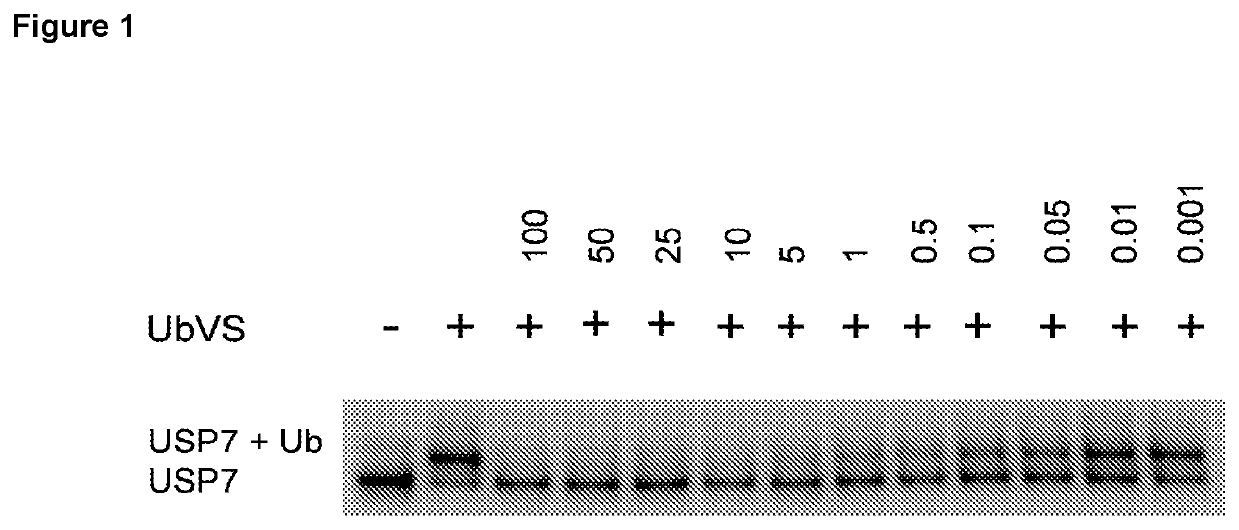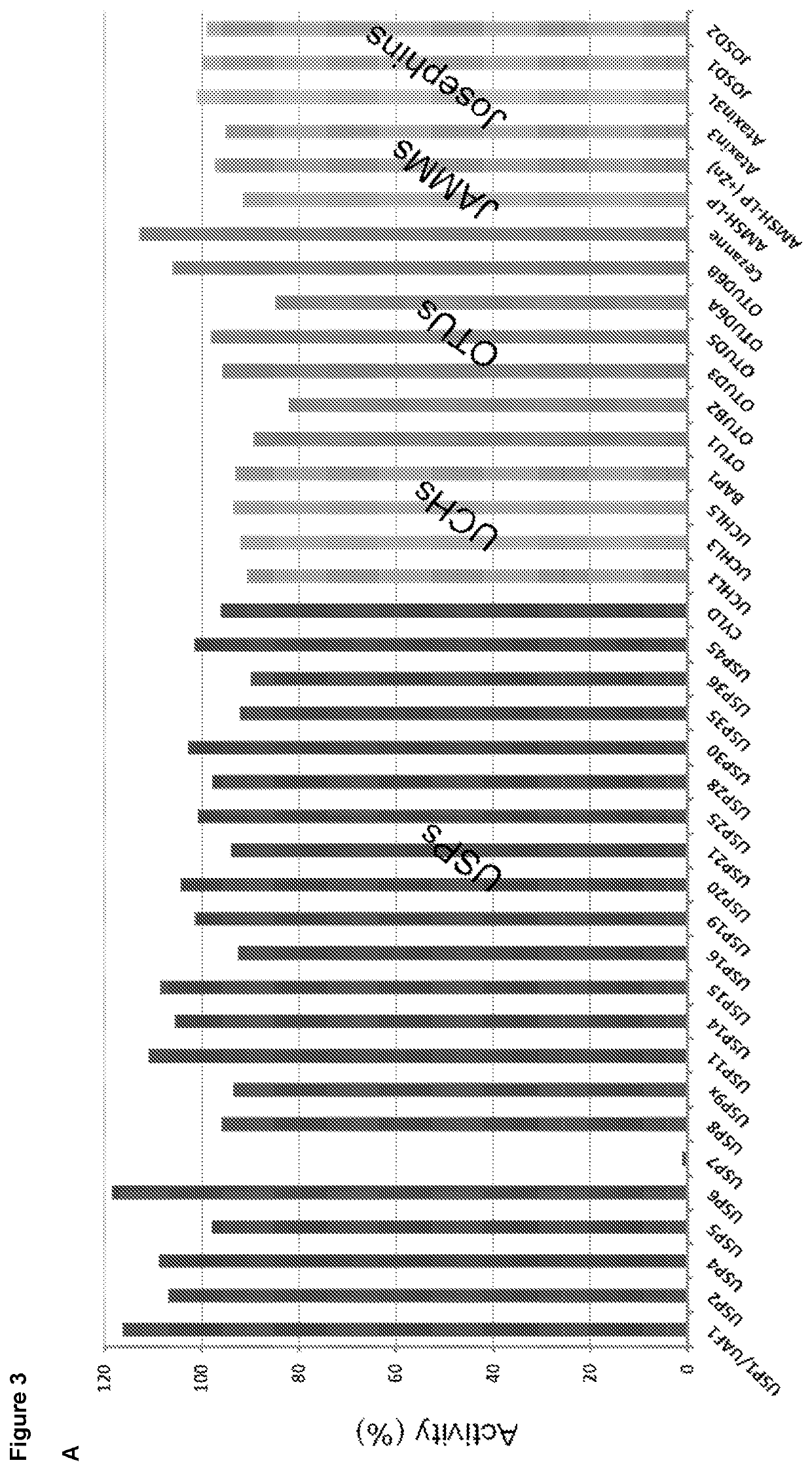Piperidine derivatives as inhibitors of ubiquitin specific protease 7
a protease and inhibitor technology, applied in the direction of organic chemistry, organic active ingredients, drug compositions, etc., can solve the problems of poor survival, severe clinical utility, and correlation with tumor aggressiveness, and achieve the effect of greater activity
- Summary
- Abstract
- Description
- Claims
- Application Information
AI Technical Summary
Benefits of technology
Problems solved by technology
Method used
Image
Examples
example 1
oro-3-((4-hydroxy-1-(3-phenylbutanoyl)piperidin-4-yl)methyl)pyrimidin-4(3H)-one (Intermediate A)
[0518]
[0519]A suspension of 6-chloropyrimidin-4(3H)-one (U.S. Pat. Appl. Publ., 20090149466, 11 Jun. 2009) (200 mg, 1.53 mmol), Epoxide 2 (397 mg, 1.53 mmol) and DIPEA (401 μl, 2.30 mmol) in DMF (3 mL) was heated at 80° C. for 16 h. The reaction mixture was then allowed to cool to RT and was quenched by the addition of saturated NH4Cl(aq) (20 mL). The mixture was extracted with EtOAc (3×20 mL), the combined organic extracts were dried over Na2SO4, concentrated, and the residue was purified by flash chromatography (Biotage 25 g KP-Sil, 0-100% EtOAc in PE then 0-30% MeOH in EtOAc) to give the title compound (350 mg, 59%) as a pale yellow solid. LCMS (Method A): RT=1.11 min, m / z=390, 392 [M+H]+. 1H NMR (300 MHz, methanol-d4, this molecule appears as two conformers A and B in a 2:3 ratio respectively): δ 8.28 (s, 0.4H (conformer A)), 8.24 (s, 0.6H (conformer B)), 7.38-7.13 (m, 5H), 6.58 (s, 1...
example 2
-Hydroxy-1-(3-phenylbutanoyl)piperidin-4-yl)methyl)-6-(pyridin-4-yl)pyrimidin-4(3H)-one
[0520]
[0521]General procedure 5 using Intermediate A (25 mg, 0.064 mmol), pyridin-4-ylboronic acid (12 mg, 0.096 mmol), Na2CO3 (14 mg, 0.128 mmol), Pd(PPh3)4(3.7 mg, 3.21 μmol), 1,4-dioxane (0.4 mL) and water (0.16 mL) in a sealed tube under microwave heating at 150° C. for 10 min gave the title compound (24 mg, 86%) as a colourless solid. LCMS (Method A): RT=0.81 min, m / z=433 [M+H]+. 1H NMR (300 MHz, CDCl3, this molecule appears as two conformers A and B in a 2:3 ratio respectively): δ 8.76-8.62 (m, 2H), 8.23 (s, 0.4H (conformer A)), 8.13 (s, 0.6H (conformer B)), 7.83-7.71 (m, 2H), 7.40-7.13 (m, 5H), 6.95 (s, 1H), 4.49-4.23 (m, 1H), 4.21-3.80 (m, 3H), 3.67-3.47 (m, 1H), 3.44-2.87 (m, 3H), 2.72-2.59 (m, 1H), 2.59-2.42 (m, 1H), 1.68-1.21 (m, 7H), 0.94-0.71 (m, 0.6H (conformer B only)).
example 3
-Hydroxy-1-(3-phenylbutanoyl)piperidin-4-yl)methyl)-6-(1H-pyrazol-5-yl)pyrimidin-4(3H)-one
[0522]
[0523]General procedure 5 using Intermediate A (25 mg, 0.064 mmol), (1H-pyrazol-5-yl)boronic acid (11 mg, 0.096 mmol), Na2CO3 (14 mg, 0.128 mmol), Pd(PPh3)4(3.7 mg, 3.21 μmol), 1,4-dioxane (0.4 mL) and water (0.16 mL) in a sealed tube under microwave heating at 150° C. for 10 min gave the title compound (19 mg, 70%) as a colourless solid. LCMS (Method A): RT=0.921 min, m / z=422 [M+H]+. 1H NMR (300 MHz, CDCl3, this molecule appears as two conformers A and B in a 2:3 ratio respectively): δ 8.28 (s, 0.4H (conformer A)), 8.18 (s, 0.6H (conformer B)), 7.65-7.56 (m, 1H), 7.37-7.14 (m, 5H), 7.05-6.92 (m, 1H), 6.81-6.71 (m, 1H), 4.44-4.20 (m, 1H), 4.21-3.79 (m, 2H), 3.65-2.86 (m, 4H), 2.71-2.57 (m, 1H), 2.57-2.41 (m, 1H), 1.63-1.21 (m, 7H), 0.90-0.73 (m, 0.6H (conformer B only)).
PUM
 Login to View More
Login to View More Abstract
Description
Claims
Application Information
 Login to View More
Login to View More - R&D
- Intellectual Property
- Life Sciences
- Materials
- Tech Scout
- Unparalleled Data Quality
- Higher Quality Content
- 60% Fewer Hallucinations
Browse by: Latest US Patents, China's latest patents, Technical Efficacy Thesaurus, Application Domain, Technology Topic, Popular Technical Reports.
© 2025 PatSnap. All rights reserved.Legal|Privacy policy|Modern Slavery Act Transparency Statement|Sitemap|About US| Contact US: help@patsnap.com



